Notes: Garstang & Catterall was opened as simply Garstang by the Lancashire & Preston Junction Railway (L&PJR) as part of their line between Preston and Lancaster on 25 June 1840. The 20 mile double track line had been authorised on 5 May 1837 and its purpose was to connect Lancaster with the North Union Railway (NUR), which ran between Preston and a junction with the Liverpool & Manchester Railway (L&M) at Lowton.
 The station was 1½ miles to the south-west of the town of Garstang on the north side of Ray Lane, which passed under the line. It was a very basic station having just a platform for each track and a two-story station house situated on the up side (east side) of the line, close to where Ray Lane ran under the railway. The station was 1½ miles to the south-west of the town of Garstang on the north side of Ray Lane, which passed under the line. It was a very basic station having just a platform for each track and a two-story station house situated on the up side (east side) of the line, close to where Ray Lane ran under the railway.
Directly to the west of the station was the Lancaster Canal, which had opened in 1819.
At the time of opening there were no goods facilities at the station.
From 22 September 1846 trains of the Lancaster & Carlisle Railway (L&C) started to run through Garstang station and from 1 August 1849 they took on management responsibility for the line. The L&C trains were operated by the London & North Western Railway (LNWR). By November 1849 northbound trains could travel all the way to Glasgow. A west coast trunk route linking London and Glasgow had been created. Garstang was on this main line but it was very much a local station served by local trains.
On 10 September 1859 the L&C leased itself to the LNWR.
On 5 December 1870 Garstang became a junction station when the Garstang & Knot (sic) End Railway (G&KER) opened a 7 mile line from the station to Pilling. The opening of the G&KER required alterations to be made at Garstang which started to be referred to as the junction station (as the G&KER had a Garstang station of their own located in the town). The embankment was widened on its west side and the down platform became an island platform. Its western face served the G&KER trains.
Goods facilities were also provided on the southern side of Ray Lane on the western side of the line. The goods facilities included a goods warehouse.
The G&KER was physically connected to the LNWR main line via the goods yard and there was no through running of ordinary passenger trains from one system to the other.

On 21 July 1879 the LNWR absorbed the L&C company.
In 1873 the LNWR provided the station with better passenger facilities. They built a large single storey brick building on the up platform just to the north of the station house. A waiting shelter was provided on the down platform. A footbridge was also installed at the southern end of the platforms.
On 21 July 1879 the LNWR absorbed the L&C company and in 1881 they renamed Garstang (Junction) as Garstang & Catterall.
On 1 July 1908 the G&KER was taken over by the Knott End Railway (KER) Company, who opened a 4½ mile extension between Pilling and Knott End on 30 July 1908.
On 1 January 1923 the LNWR was absorbed into the London, Midland & Scottish Railway (LMS) and the KER followed suit on 1 July 1923.
On 31 March 1930 the LMS withdrew the passenger service between Garstang & Catterall and Knott End but goods services continued to run on that line.
 Garstang & Catterall became part of British Railways London Midland Region (BR[LMR]) on 1 January 1948. On 13 November 1950 goods services ceased to run to Knott End and Pilling became the western terminus of that branch. Goods services continued to run to Pilling until 1 August 1963 after which the branch was cut back to Garstang Town. Garstang & Catterall became part of British Railways London Midland Region (BR[LMR]) on 1 January 1948. On 13 November 1950 goods services ceased to run to Knott End and Pilling became the western terminus of that branch. Goods services continued to run to Pilling until 1 August 1963 after which the branch was cut back to Garstang Town.
Garstang & Catterall was listed for closure in the 1963 ‘Reshaping of British Railways’ report (the Beeching report) but for some reason it took BR[LMR] quite some time to get around to actually closing the station. Closure to goods came first on 30 December 1968 with complete closure following on 3 February 1969.
The station was demolished after closure and in 2020 only the 1840 station house remained. As part of the West Coast Main Line the former L&PJR line continues to be a busy main line railway.
CLICK HERE FOR A DETAILED HISTORY OF GARSTANG & CATTERALL STATION
Route map by Alan Young
Sources:
- Awdry, C British railway companies (Guild Publishing,1990)
- Clinker, C R Clinker’s register of closed passenger stations and goods depots in England, Scotland and Wales 1830-1977 (Avon-Anglia,1978)
- Cobb, M H The Railways of Great Britain – vol.1 (Third Edition) (Author, 2015)
- Holt, G O A Regional History of the Railways of Great Britain – vol.10 (David & Charles, 1978)
- Quick, Michael Railway passenger stations in Great Britain - a chronology (RCHS, 2009 and on-line supplements)
- Richardson, D The Pilling Pig - A History of the Garstang and Knott End Railway (Cumbrian Railways Association, 2019)
To see the
other closed of the Knott End Branch
click on the station name: Garstang Town, Nateby, Cogie Hill, Cockerham Cross, Garstang Road, Pilling,
Carr Lane, Preesall and Knott End
Click here to see Register of Closed Railways 1901 - 1994 |

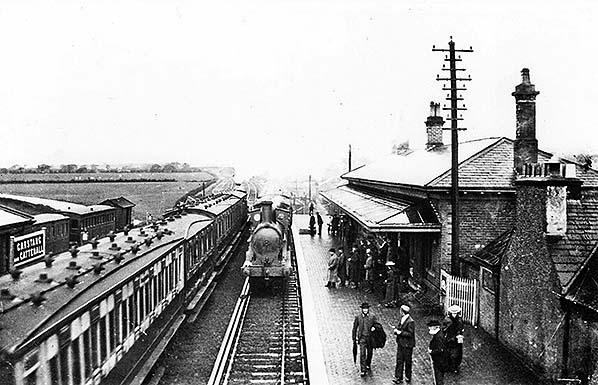 A busy scene at Garstang & Catterall in this view looking north in the early 20th Century. Trains can be seen at all three platform faces. To the far left is a G&KER train that would have recently arrived from Pilling. A northbound LNWR service is seen to the left and a southbound service is just arriving at the up platform. Judging by the amount of passengers this view was probably taken in the early morning.
A busy scene at Garstang & Catterall in this view looking north in the early 20th Century. Trains can be seen at all three platform faces. To the far left is a G&KER train that would have recently arrived from Pilling. A northbound LNWR service is seen to the left and a southbound service is just arriving at the up platform. Judging by the amount of passengers this view was probably taken in the early morning.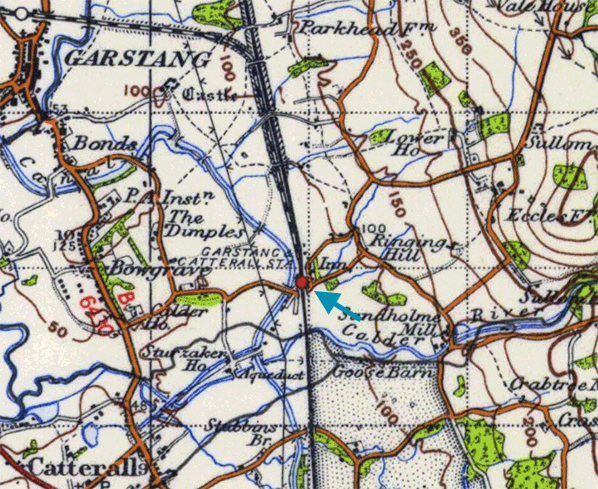
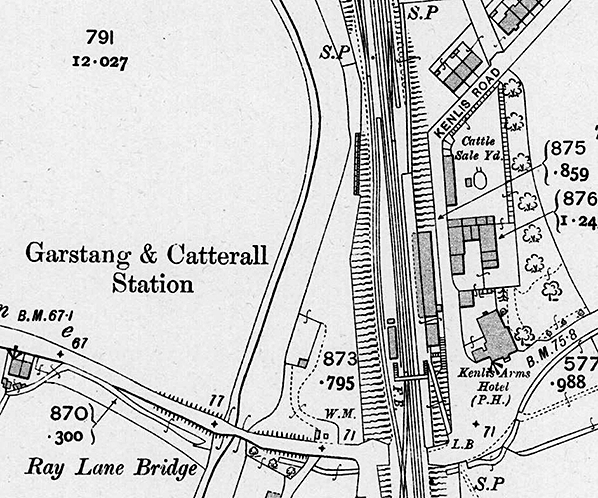
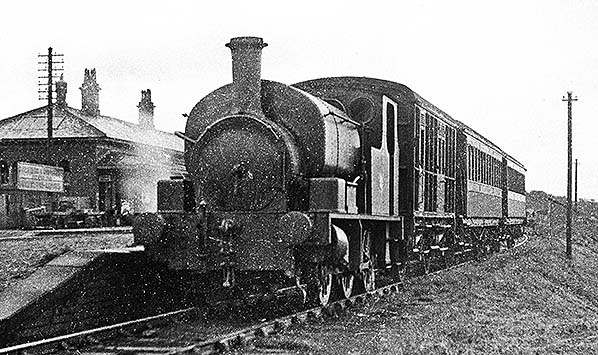 A KER train is seen at Garstang & Catterall station in 1920.
A KER train is seen at Garstang & Catterall station in 1920. The station was 1½ miles to the south-west of the town of Garstang on the north side of Ray Lane, which passed under the line. It was a very basic station having just a platform for each track and a two-story station house situated on the up side (east side) of the line, close to where Ray Lane ran under the railway.
The station was 1½ miles to the south-west of the town of Garstang on the north side of Ray Lane, which passed under the line. It was a very basic station having just a platform for each track and a two-story station house situated on the up side (east side) of the line, close to where Ray Lane ran under the railway.
 Garstang & Catterall became part of British Railways London Midland Region (BR[LMR]) on 1 January 1948. On 13 November 1950 goods services ceased to run to Knott End and Pilling became the western terminus of that branch. Goods services continued to run to Pilling until 1 August 1963 after which the branch was cut back to Garstang Town.
Garstang & Catterall became part of British Railways London Midland Region (BR[LMR]) on 1 January 1948. On 13 November 1950 goods services ceased to run to Knott End and Pilling became the western terminus of that branch. Goods services continued to run to Pilling until 1 August 1963 after which the branch was cut back to Garstang Town.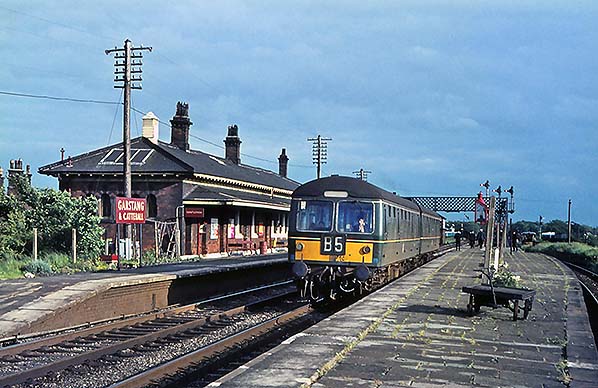 On 20 June 1967 a Cravens type DMU is seen departing from the Garstang & Catterall down platform. The train was most probably a service for Barrow-in-Furness.
On 20 June 1967 a Cravens type DMU is seen departing from the Garstang & Catterall down platform. The train was most probably a service for Barrow-in-Furness.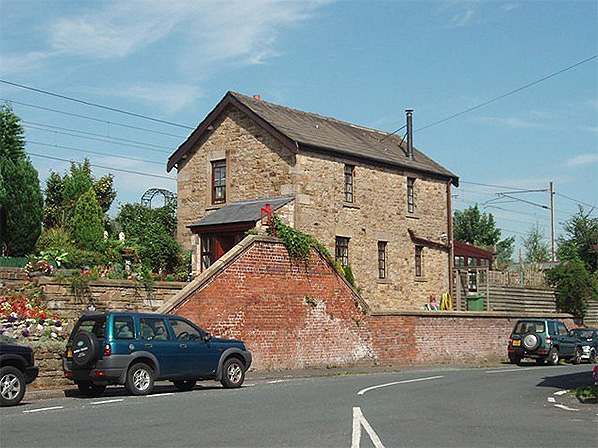 The Garstang & Catterall station house of 1840 seen on 25 July 2008.
The Garstang & Catterall station house of 1840 seen on 25 July 2008.
 Home Page
Home Page